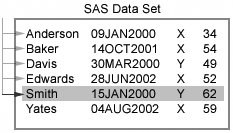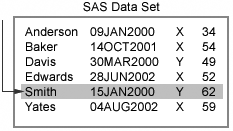Using Indexes
Overview
An index can help you quickly locate one or more observations
that you want to read. Indexes provide direct access to observations
in SAS data sets based on values of one or more key variables. Index
applications include the following:
-
-
perform table lookup operations
-
join observations
Without an index, SAS
accesses observations sequentially, in the order in which they are
stored in a data set. For example, to access the observation in the
sample SAS data set shown below that has a value of
Smith for
the variable Name, SAS begins with the first observation and reads
through each one until it reaches the observation that satisfies the
condition.
When
you index a SAS data set, SAS creates an index file that stores values
in ascending value order for a specific variable or variables and
includes information about the location of those values in the data
file. That is, an index consists of value/identifier pairs that enable
you to locate an observation by value. For example, if you create
an index on the sample SAS data set that is shown below based on the
variable Name, SAS uses the index to find the observation that has
a value of
Smith for Name directly
without having to read all the prior observations.
Types of Indexes
You can create two types of indexes:
-
a simple index
-
a composite index
A simple index consists
of the values of one key variable, which can be character or numeric.
When you create a simple index, SAS names the index after the key
variable.
A composite index consists
of the values of multiple key variables, which can be character, numeric,
or a combination. The values of these key variables are concatenated
to form a single value. For example, if an index is built on the key
variables Lastname and Firstname, a value for the index includes the
value for Lastname followed by the value for Firstname. When you create
a composite index, you must specify a unique index name that is not
the name of any existing variable or index in the data set.
Often, only the first
variable of a composite index is used. In the example, you could use
the composite index that is specified in the example above (Lastname
plus Firstname) for a WHERE expression that uses only Lastname. For
example, the expression
where Lastname='Smith' uses
the composite index because Lastname is the first variable in the
index. That is, the value for Lastname is the first part of the value
that is listed in the index.
..................Content has been hidden....................
You can't read the all page of ebook, please click here login for view all page.


